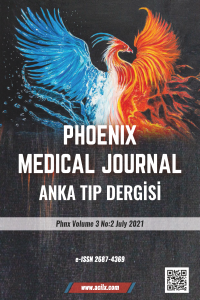Abstract
An 84-year-old female patient applied to the emergency service with neck pain. The patient fell lost in the bathroom. In the anamnesis of the patient, it is seen that she had diabetes mellistus, hypertension and no other history of disease. On her physical examination, the vital signs of were with in normal limits and there was tenderness on both scapula and midline tenderness on cervical vertebra. Computed tomography showed that fragmented fracture on cervical second vertebral corpus. The patient was discharged with a collar and analgesics.
Axis fractures are classified into three groups. These are; odontoid fractures, hangman fractures (traumatic spondylolysis) and nonodontoid nonhangman fractures (1). Odontoid and hangman fractures are relatively common fractures of the axis (1). Our case was nonodontoid nonhangman fracture which is the rarest type of axis fractures. In our case, conservative treatment was preferred because of it was Benzel type 1 fracture and had no accompanying soft tissue injury (2).
Keywords
References
- 1. Benzel EC, Hart BL, Ball PA, et al: Fractures of the C-2 vertebral body. J Neurosurg. 1994;81:206–12.
- 2. Ryken TC, Hadley MN, Aarabi B, Dhall SS, Gelb DE, Hurlbert RJ, et al: Management of isolated fractures of the axis in adults. J Neurosurg. 2013;72 (2):132–50.
Abstract
An 84-year-old female patient applied to the emergency service with neck pain. The patient fell lost in the bathroom. In the anamnesis of the patient, it is seen that she had diabetes mellistus, hypertension and no other history of disease. On her physical examination, the vital signs of were with in normal limits and there was tenderness on both scapula and midline tenderness on cervical vertebra. Computed tomography showed that fragmented fracture on cervical second vertebral corpus. The patient was discharged with a collar and analgesics.
Axis fractures are classified into three groups. These are; odontoid fractures, hangman fractures (traumatic spondylolysis) and nonodontoid nonhangman fractures (1). Odontoid and hangman fractures are relatively common fractures of the axis (1). Our case was nonodontoid nonhangman fracture which is the rarest type of axis fractures. In our case, conservative treatment was preferred because of it was Benzel type 1 fracture and had no accompanying soft tissue injury (2).
Keywords
References
- 1. Benzel EC, Hart BL, Ball PA, et al: Fractures of the C-2 vertebral body. J Neurosurg. 1994;81:206–12.
- 2. Ryken TC, Hadley MN, Aarabi B, Dhall SS, Gelb DE, Hurlbert RJ, et al: Management of isolated fractures of the axis in adults. J Neurosurg. 2013;72 (2):132–50.
Details
| Primary Language | English |
|---|---|
| Subjects | Emergency Medicine |
| Journal Section | Image Presentation |
| Authors | |
| Publication Date | July 1, 2021 |
| Submission Date | February 22, 2021 |
| Acceptance Date | March 10, 2021 |
| Published in Issue | Year 2021 Volume: 3 Issue: 2 |

Phoenix Medical Journal is licensed under a Creative Commons Attribution 4.0 International License.
Phoenix Medical Journal has signed the Budapest Open Access Declaration.



